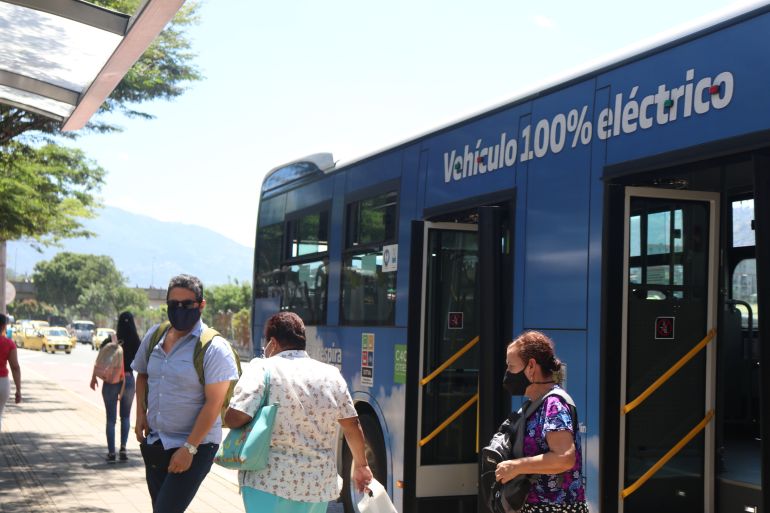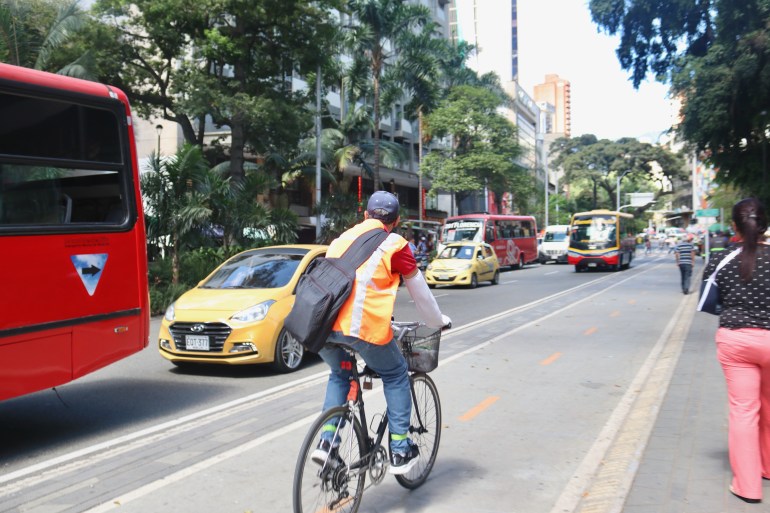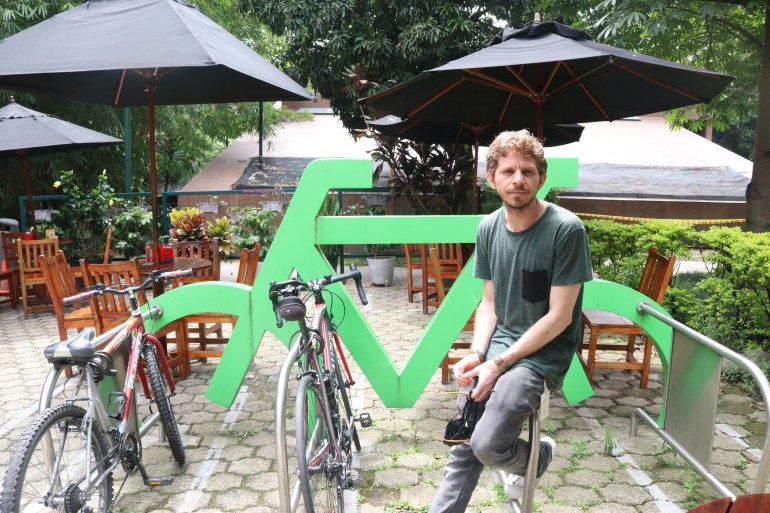Medellin strives to become Latin America’s first ‘eco-city’
The Colombian city, notorious decades ago for its crime and violence, is reinventing itself.

Medellin, Colombia — About 30 years ago, Medellin was considered one of the most dangerous cities in the world. Drug cartels reigned, homicides and explosions were commonplace, and only the foolish strolled the streets at night.
Through a series of smart investments in poor communities, transportation infrastructure, schools, technology and public parks, the city has transformed itself into a model of urban planning and innovation, garnering international recognition for its entrepreneurialism and modernity.
Keep reading
list of 3 itemsGhosts of Medellin
The Colombia Uprising
Now, Medellin wants to reinvent itself again – this time as Latin America’s first “eco-city” with wide-ranging initiatives in renewable energy, transportation, housing, water management and waste.
As governments and investors around the world direct funds towards pandemic recovery efforts, cities like Medellin are taking the opportunity to simultaneously set a climate-friendly agenda for years to come.
Colombia has recently started to reopen most large events, even as COVID-19 cases continue to climb, to boost the country’s devastated economy. And the mayor of Medellin, Daniel Quintero, has said that its post-COVID revival will go hand in hand with its climate goals.
“What’s been happening is triggering huge transformations within people and institutions in general,” Quintero told Reuters last year.
The government’s ambitious plans are to cut carbon emissions by 20 percent, electrify all public transport by 2030, expand bike lanes by 50 percent, and double the number of public transport lines.

Medellin already has an advantage with Colombia’s only metro system, along with bike lanes, a fleet of electric buses, and its “green corridors” network of urban greenery that line congested streets.
The city in January opened a new electric charging station for its fleet of 69 electric buses – and there are plans to nearly double that in the next three years, and to build an electric light rail.
But some politicians and activists have said that, for the most part, the administration is big on lofty promises and short on the political will to enact them.
Post-COVID ‘sustainability’ push
One strategy to meet the city’s economic and climate goals is to locally manufacture parts for a decarbonized mass transport system, said Jaime Arenas Plata, the director of Medellin’s Sustainable Energy Cluster — part of the city’s “cluster” system of public-private partnerships that aim to boost economic growth.
While 70 percent of spare parts for the metro are manufactured locally, the city currently buys its electric buses from a Chinese company. But Arenas has said the contract expires at the end of next year and he is hoping to see a deal to manufacture many of those electric vehicles locally.
“We do believe that these sustainability issues are a boost for the economy in the face of the post-COVID recovery,” said Arenas.

And sustainable tourism also has a role to play in achieving those goals, said Rodrigo Atuesta, president of the Colombian Association of Responsible Tourism (ACOTUR), by drawing tourists to less urbanised areas under threat from the oil and mining industries.
This strategy has proven particularly successful in Costa Rica, long considered the model for eco-tourism. Pre-pandemic, the country boasted eco-tourism as one of its main industries while maintaining strong conservation protections. Conversely, in the Brazilian Amazon, successful eco-tourism hotspots have found themselves under threat from land grabs and illegal deforestation and construction.
“We are very clear that sustainability does not only mean research on the use of plastic. It is not only the issue of carbon offsets,” said Atuesta. “That’s important, but sustainability also has to do with us as companies actively identifying community projects and working with them to integrate them into the value chain.”
Empty promises?
But the city’s budget is a sticking point for many, including Santiago Londono Uribe, who has previously served as a city council member and Secretary of Government for the province of Antioquia. He points out that the budget for the Ministry of the Environment was slashed from approximately 79 million Colombian pesos ($20,645) — already a 10-year low — to 57 million pesos ($14,896) this past year.
“That doesn’t make sense because part of the coherence between a project and its execution is the budget,” he said. “You can talk about the beauties of the eco-city, but if you don’t have a consistent and coherent budget commitment, it is very difficult to achieve it.”
Daniel Duque, a city council member of the left-leaning Green Alliance party, said he voted against this year’s budget in part because of budget cuts to the environment.
“[The mayor] intends some things in his speeches that, unfortunately, in reality, cannot be true because there is no political will, no budget, and no suitable people in charge of many of these tasks,” said Duque.
Statements from the secretary of the environment said that the budget was cut due to the pandemic, and that they expected to increase resources in 2022 and 2023, in addition to sharing resources with the Metropolitan Area as an environmental authority.
The administration “is expected to continue on the path of turning Medellin into an Eco-city” read the statement, and pointed towards its efforts on reforestation, public transport and air quality.

But Londono, Duque and environmental activist Daniel Suarez Montoya all expressed concerns about recent changes in the city’s cabinet, which they said replaced qualified officials with traditional politicians or political allies. Suarez saw this as a setback for the city’s environmental goals. For example, the former transportation secretary was committed to the “eco-city”, he said, while the current one is simply a “politician”.
The current transportation secretary did not respond to requests for comment by the time of publication.
Lack of regional inclusion
Suarez also took issue with the fact that many of the urban policies fail to take into account Medellin’s interconnectedness with its surrounding area. The city falls within The Metropolitan Area of the Aburra Valley, which includes nine other municipalities.
These municipalities are so interconnected, he said, that environmental policies should consider the activities of the entire region.
For example, while many of the region’s municipalities have taken measures to combat Medellin’s notoriously high levels of air pollution, the municipality of Girardota, which houses the majority of polluting industries, has not. And when Medellin restricted building height to limit population growth in the city, many developers moved to the southern municipalities like Sabaneta which saw excessive growth, straining the small city’s mobility, public space and security.
“I really believe that it is of little use for a city like Medellin to be thinking of something as important as that ‘eco-city’ without the other municipalities working towards the same path,” said Suarez. “Because it is a half-effort that ends up being transferred to the other municipalities in a negative way.”
Furthermore, while Medellin has racked up international recognition, Suarez said that the preoccupation with its image on the world stage can be distracting – pointing out that the touted prize for “most innovative city of the year” was decided by online voting.
“The city cares more internationally for its image than for actually making the changes internally,” he said. “I, as a Medellíncense, as a person who was born here, who works for the city, I think we have done ourselves a lot of damage because we prioritise maintaining our image instead of working for it.”
Suarez pointed out that despite the goals to create an equitable and sustainable society, high rates of inequality and extreme poverty continue to be challenges for the city.
“These people who come to power care more about the image of the city at an international level to generate that recognition,” he said. “But in the background, it is not generating a social transformation.”